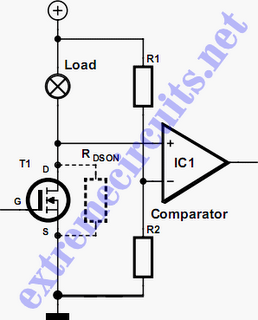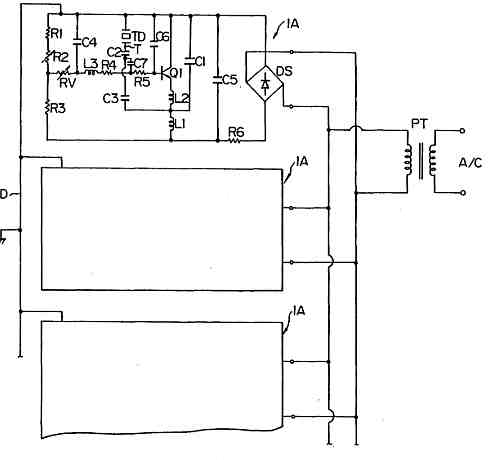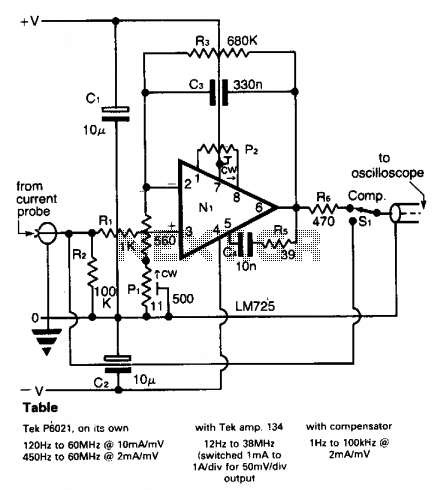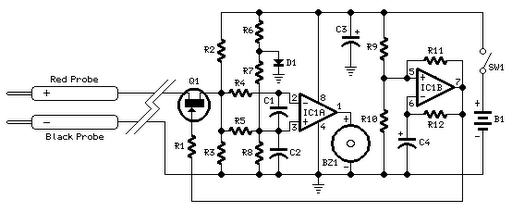
20 amp output circuit

A series capacitor is most effective for low impedance loads, while a parallel capacitor is utilized for high impedance loads. The current standard is a 50-ohm antenna and coax system that requires a series capacitor for loading adjustment. With switch SW3, it is possible to completely remove the series capacitor or introduce additional capacitance, allowing for a total capacitance range from approximately 20pF to 900pF. The tuning process resembles that of a pi network, involving a "dip and load" technique. With SW3 and capacitor C5 set to the minimum capacitance, the plate current is adjusted by dipping using capacitor C4. After this adjustment, the loading capacitance is increased through capacitors C5, C6, and C7 to reach the desired operating plate current, followed by another dip adjustment using C4. The interaction between capacitors C4, C5, C6, and C7 necessitates repeating this process until the final adjustment of C4 sets the plate current to the required level for full output, which in this case is approximately 150 mA. At 500 VDC on the TZ-20 plates with 150 mA, an input power of 75 watts is achieved.
The circuit employs a combination of series and parallel capacitors to optimize performance based on load impedance. In low impedance scenarios, a series capacitor is preferred, while high impedance conditions benefit from the use of a parallel capacitor. The system is designed to operate within a 50-ohm framework, which is critical for effective antenna and coaxial cable integration.
Switch SW3 serves as a pivotal component in this setup, enabling the operator to either bypass the series capacitor entirely or augment the capacitance as required. This feature is particularly useful for fine-tuning the circuit to achieve optimal performance across a broad range of capacitance values, from 20pF to 900pF. The tuning methodology employed is akin to that of a pi network, which is characterized by a "dip and load" approach. This technique involves adjusting the plate current by manipulating the capacitors in a specific sequence to achieve the desired output.
Capacitor C4 is primarily responsible for the initial plate current dip, which is a critical step in the tuning process. After achieving the dip, the loading capacitance is progressively increased through capacitors C5, C6, and C7. This gradual adjustment allows for precise control over the operating plate current, ensuring that it remains within the desired range. The interaction among capacitors C4, C5, C6, and C7 is significant, as each capacitor influences the others, necessitating a careful and iterative tuning process.
Ultimately, the goal is to stabilize the plate current at approximately 150 mA. Under these conditions—specifically, with 500 VDC applied to the TZ-20 plates—the circuit is capable of delivering an input power of 75 watts. This design showcases the intricate balance between various components and their roles in achieving efficient circuit performance in RF applications.A series capacitor worked best for low impedance loads while a parallel capacitor was used to feed into high impedance loads. Today`s norm is a 50 ohm antenna antenna/coax system requiring a series capacitor. loading adjustment. With SW3 I can switch out the series capacitor all together or add in additional capacitance to give me a total
range from about 20pF to 900pF. Tune up becomes very much like a pi network "dip and load". With SW3 and C5 set for minimum capacitance the plate current is dipped using C4. After dipping, the loading capacitance is increased using C5, C6 and C7 into the range of operating plate current and then the current redipped using C4. C4, C5, C6 and C7 interact so this process must be repeated until the last C4 adjustment puts the plate current where it needs to be for full output.
in my case about 150 mA. 500 VDC on the TZ-20 plates at 150 mA gives me 75 watts input. 🔗 External reference
The circuit employs a combination of series and parallel capacitors to optimize performance based on load impedance. In low impedance scenarios, a series capacitor is preferred, while high impedance conditions benefit from the use of a parallel capacitor. The system is designed to operate within a 50-ohm framework, which is critical for effective antenna and coaxial cable integration.
Switch SW3 serves as a pivotal component in this setup, enabling the operator to either bypass the series capacitor entirely or augment the capacitance as required. This feature is particularly useful for fine-tuning the circuit to achieve optimal performance across a broad range of capacitance values, from 20pF to 900pF. The tuning methodology employed is akin to that of a pi network, which is characterized by a "dip and load" approach. This technique involves adjusting the plate current by manipulating the capacitors in a specific sequence to achieve the desired output.
Capacitor C4 is primarily responsible for the initial plate current dip, which is a critical step in the tuning process. After achieving the dip, the loading capacitance is progressively increased through capacitors C5, C6, and C7. This gradual adjustment allows for precise control over the operating plate current, ensuring that it remains within the desired range. The interaction among capacitors C4, C5, C6, and C7 is significant, as each capacitor influences the others, necessitating a careful and iterative tuning process.
Ultimately, the goal is to stabilize the plate current at approximately 150 mA. Under these conditions—specifically, with 500 VDC applied to the TZ-20 plates—the circuit is capable of delivering an input power of 75 watts. This design showcases the intricate balance between various components and their roles in achieving efficient circuit performance in RF applications.A series capacitor worked best for low impedance loads while a parallel capacitor was used to feed into high impedance loads. Today`s norm is a 50 ohm antenna antenna/coax system requiring a series capacitor. loading adjustment. With SW3 I can switch out the series capacitor all together or add in additional capacitance to give me a total
range from about 20pF to 900pF. Tune up becomes very much like a pi network "dip and load". With SW3 and C5 set for minimum capacitance the plate current is dipped using C4. After dipping, the loading capacitance is increased using C5, C6 and C7 into the range of operating plate current and then the current redipped using C4. C4, C5, C6 and C7 interact so this process must be repeated until the last C4 adjustment puts the plate current where it needs to be for full output.
in my case about 150 mA. 500 VDC on the TZ-20 plates at 150 mA gives me 75 watts input. 🔗 External reference





